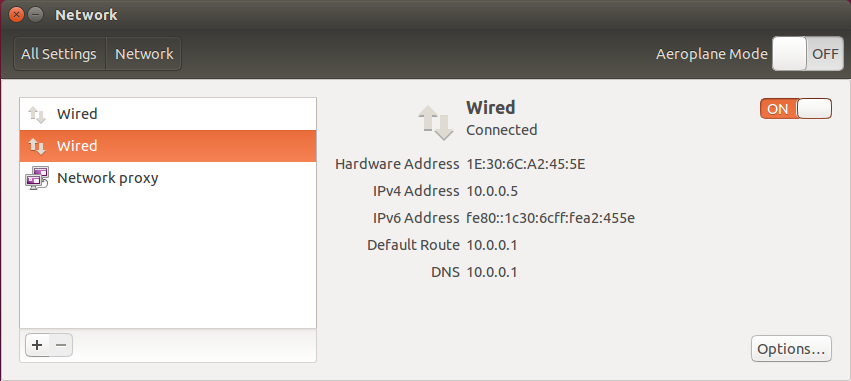

- #Amazonbasics usb ethernet adapter debian mac osx
- #Amazonbasics usb ethernet adapter debian drivers
- #Amazonbasics usb ethernet adapter debian driver
Ip route add default via 192.168.1.1 dev br0 Or static (assuming the gateway): ip addr add 192.168.1.51/24 dev br0 They are not capable of any added features NAS/network printers/anything like that ( I guess that's because these are router features and the cable is just a physical adapter which does not transform the data by any protocols). To acquire an IP from DHCP: dhclient -v br0 These USB to Ethernet adapters have a fixed, singular use case of providing internet via Ethernet to a USB port. StarTech USB USB31000S 3.0 to Gigabit Ethernet NIC Network Adapter Buy On AmazonBuy On.
#Amazonbasics usb ethernet adapter debian mac osx
Debian can't find/recognize it, and i don't know what to do. Works with Windows 10, Mac OSX 10.6 to 10.12, Linux, and Chrome OS. The installation went rather well, except for the network adapter. Now the bridge can be treated as an ordinary NIC. Earlier today i installed latest Debian (buster) on a Dell PowerEdge 2900 server. Setup the bridge: ip link add br0 type bridgeĪssign the 2 physical NICs to the bridge (they lose settings when assigned) ip link set enp2s0 master br0 ( sudo in front of each command, or sudo su to switch to root shell) The adapter measures 2.04 by 0.81 by 0.65 inches. Available in black or white and weighing just 0.74 ounces, the adapter easily matches surrounding hardware and accessories and offers lightweight portability. After you are happy with the result, move the configuration to /etc/network/interfaces. The AmazonBasics USB 3.1 Type-C to Ethernet Adapter works with Windows 10/8.1/8, Mac OS, and Chrome. I suggest you to try to setup a bridge manually at first, using commands on shell. Next, if network manager is installed, stop it before you proceed it may try to setup interfaces by itself. The interfaces are still set up in /etc/network/interfaces file. I'll try to give you a hand in achieving it though :)įirst of all, systemd-networkd is not used in Debian 10 Buster. To be honest I cannot understand what you need to achieve. How can I tell if I've got that? Which is the correct way to do it? If not this file then does this mean that is now completely wrong? Is there some correct documentation? I heard that maybe this file is being ignored because of something called systemd-networkd. Is it even possible to join two physical networks like this?
#Amazonbasics usb ethernet adapter debian driver
Link/ether 00:80:8e:8c:92:f8 brd ff:ff:ff:ff:ff:ff GITRU USB 3.0 to Ethernet Adapter, Driver Free 10/100/1000 Mbps Network RJ45 LAN Wired Gigabit Ethernet Adapter for Windows 10, 8. Link/ether 00:16:cb:9c:eb:ce brd ff:ff:ff:ff:ff:ffģ: enx00808e8c92f8: mtu 1500 qdisc noop state DOWN group default qlen 1000 ip aġ: lo: mtu 65536 qdisc noqueue state UNKNOWN group default qlen 1000

Having read I came up with # The loopback network interfaceīut this ends up with no network at all. I want to bridge this with a USB ethernet adapter so that everything on each side can see everything on the other side, all with 192.168.1.0 addresses, as if everything was plugged into the same switch. These upper layers then will take care of other steps, sometimes using interactions with user space, to initialize the network interface, set routes etc.I have Debian 10 (no X11 because it doesn't work) on an iMac that has built in ethernet that I can configure using /etc/network/interfaces and it works.

The driver itself will take care of telling the kernel that it represents a device that has a representation in other kernel layers, e.g. The rest of the aliases matches on values in the USB descriptor.Īll aliases are collected into a modules_alias file (in /lib/modules//), and then the kernel uses this file to decide which driver to activate when a new device (USB or other) is found. If you do for example modinfo cdc_ether, you'll see quite a number of aliases starting with usb. I guess when this device is plugged in, udev sets it up, but how does it know that this USB device is actually used as an interface that connects to Ethernet and hence routes traffic over it?Īll kernel modules can contain patterns that describe for which devices they can be used.
#Amazonbasics usb ethernet adapter debian drivers
Most Ethernet-to-USB adapters are marked in the USB descriptor as a CDC device, so one of the standard drivers (there are several variants) will do for most devices. Ralink 802.11n PCI devices are supported by the rt2800pci driver. Firmware is required and available in the firmware-ralink package.

Supported devices are listed at the end of this page. The Linux kernel offered by most distros as default already contains a large number of drivers. rt2800usb is a driver produced by the rt2x00 project, supporting Ralink 802.11n USB chipsets, introduced at Linux 2.6.31. How is this working without installing any specific drivers?


 0 kommentar(er)
0 kommentar(er)
